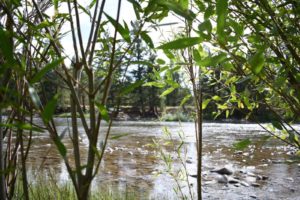 Tromping through a tangle of bushes and grasses, I listen for a trickling sound. I know there must be a small waterfall nearby. We’re in Halfmoon Park – a massive, halfmoon shaped wall stands at the top of a valley. It’s our destination on our backpack and today we have a layover day. When I reach the sound that’s guided me, I find a stream tumbling over rocks into a small pool. Its lines with squishy pads of moss and, upon closer inspection, I see that half the stream veers off into an underground channel before flowing into the next part of its journey. It’s the perfect place for a backcountry shower.
Tromping through a tangle of bushes and grasses, I listen for a trickling sound. I know there must be a small waterfall nearby. We’re in Halfmoon Park – a massive, halfmoon shaped wall stands at the top of a valley. It’s our destination on our backpack and today we have a layover day. When I reach the sound that’s guided me, I find a stream tumbling over rocks into a small pool. Its lines with squishy pads of moss and, upon closer inspection, I see that half the stream veers off into an underground channel before flowing into the next part of its journey. It’s the perfect place for a backcountry shower.
After scrubbing clothes that are beyond dirty, I take an MSR Dromedary full of water behind some bushes and scrub my body with biodegradable soap. I rinse off then return to the pool. Kneeling in the stream, I splash ice cold water on myself. There’s something I love about being in natural bodies of water like this.
Growing up in Minnesota, my summer often included a camping trip on the north shore of Lake Superior. The challenge of the ~45 degree lake often lures me in—I have to at least attempt to swim. Maybe this type of swimming entices me because of the thrill of momentarily being unable to breathe from the cold. Hardly anything could be more invigorating than a cold lake. But I think being enveloped in a lake or river is also spiritual for me. It is here that I feel most connected with the earth, and its here that my observations span out over more than just the present.
Early on our course, we read Thomas Lowe Fleischner’s Natural History and the Spiral Offering. In this essay, he names eight qualities of a good natural historian. A natural historian is someone who practices “intentional, focused attentiveness and receptivity to the more-than-human world.” One of these important qualities is vision, having the ability to “see the unseen.” In a stream, lake, or river, I’m surrounded by rocks that have been molded and shaped by water over time. This water comes from springs or ancient glaciers, or rain that’s been making its way around the loop of the water cycle as long as the earth has had water. Here, I can see the unseen, I can imagine the past and future, understanding that wherever I am will not always look like this. This waterfall looked different in the past, maybe bigger, or more jagged as it had not yet been worn down. In the future it may be more smooth, shorter, or wider. When I immerse myself in water, a marker of time, I am a part of the very thing that carves the shapes and patterns I see around me.
On our last day in the backcountry, we happened upon a series of waterfalls and pools of churning blue water. We took a dip in one of the freezing pools, unable to breathe from the shock of icy water. It trickled out of rocks and fell down small ledges and swirled at the bottoms of the deep holes it carved out for itself. I understood that the falls’ shape was ever changing as water continued to throw pebbles and stones over its surface. The past, present, and future are evident in the different aspects of the falls. Its deep holes remind me of the power of rushing water and stones in the past, and I wonder what they’ll look like in the future. This water is like nature’s clock, and swimming here allows me to crawl inside that clock and examine its little gears and cogs. It brings about a vision of myself in relation to the place. My practice of natural history has been enhanced here as the water allows me to gain a vision of the natural world that extends beyond the present moment.